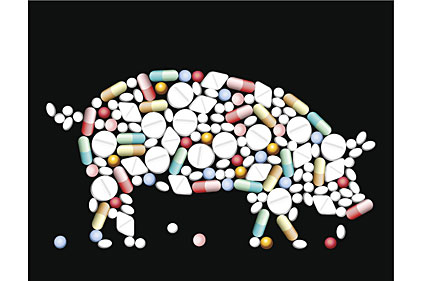Whether the use of antibiotics in animal production is responsible, in whole or in part, for the increased prevalence of antibiotic-resistant strains of pathogens in food is definitely a hard and controversial topic.
Generally, hard and controversial topics get put aside, and antibiotic resistance has been pushed aside for 40 years. However, in today’s social-media age, animal agriculture needs to recognize the issue is unlikely to go away and needs to be addressed proactively. We need to address it before there is an outbreak with multiple deaths attributed to meat or poultry with an antibiotic-resistant pathogen strain. Having lived through E. coli O157 in the 1990s, I have no desire to repeat the experience.
There is no conclusive science to support that the use of antibiotics in animal production translates to antibiotic resistance of pathogens affecting humans. However, that doesn’t mean “scientific” arguments cannot be made. For example, the Centers for Disease Control (CDC) have been monitoring the antibiotic resistance of pathogens in meat and poultry samples through the National Antibiotic Resistance Monitoring System, and have reported an upward trend in resistance to more antibiotics. The data for the same time period shows an increase usage of antibiotics in animal production.
Likewise, even though there is no specifical reporting data on illnesses caused by antibiotic-resistant pathogens, it does not stop CDC from estimating two million people become sick with antibiotic-resistant infections and at least 23,000 die each year.
Science will govern the resolution of the issue, especially when we include political science. On September 18th, the President issued an Executive Order (EO) on “Combating Antibiotic Resistant Bacteria.” In part, the EO creates a Task Force chaired by secretaries of Defense, Agriculture and Health and Human Services; the inclusion of the Secretary of Agriculture evidences the perception that agriculture is part of the problem. The President also requested increased funding for CDC to improve early detection and tracking of multidrug-resistant Salmonellaand a 20-fold increase in testing for drug-resistant Salmonella. Finally, on the policy scene, the Food and Drug Administration (FDA) is working with antibiotics manufacturers to limit labeled uses of antibiotics to treatment of disease, not for growth-promotion purposes. According to FDA, all 26 companies have agreed.
Consumer organizations are pushing to make antibiotic-resistant pathogens, primarily Salmonella, adulterants. Center for Science in the Public Interest (CSPI) has submitted a revised petition to FSIS requesting resistant Salmonellabe declared a per seadulterant in raw products. FSIS has taken the position that Salmonellagenerally is not an adulterant because it does not ordinarily render the product injurious to health. In its petition, CSPI asserts FSIS is applying the incorrect legal standard of adulteration to resistant Salmonella. According to CSPI, the antibiotic-resistant characteristics are attributed, at least in part, to the intentional use of antibiotics in animal production. Given this CSPI assertion, the correct legal standard is whether the product “may be” injurious — a standard which favors the determination that the pathogen is a per seadulterant.
On the media front, PBS’ Frontline News Program recently ran two programs on antibiotic resistance, one focusing on animal agriculture. One needs only do a Web search for antibiotic resistance and see the dozens of news stories linking resistance to animal production practices.
With this notoriety has come some change. On the production side, several poultry producers have eliminated the routine use of antibiotics, and some beef producers will not sell their branded product if the animal received antibiotics. On the customer level, an increasing number of retailers and restaurants are promising to only sell products that are made from animals that have never been given antibiotics.
Obviously, these customers will want to promote “no antibiotics used”, which means such claims must be verified. There are limited options for verification, primarily an Agricultural Marketing Service program. One of the challenges, should industry begin adopting the production claims on a widespread basis, is to meet the increased demand for verification without watering down the credibility of the verifiers.
There will be more to come on this issue. In the interim, consider the irony that one of the few certainties on antibiotic use is that FSIS policy does notpermit an “antibiotic free” claim on any meat and poultry because all foods should be free of antibiotic residues.
Dennis R. Johnson is a principal with Olsson Frank Weeda Terman Matz PC in Washington, D.C. Johnson has 30 years experience in food-safety law and regulation, representing large and small meat and poultry companies.




Report Abusive Comment